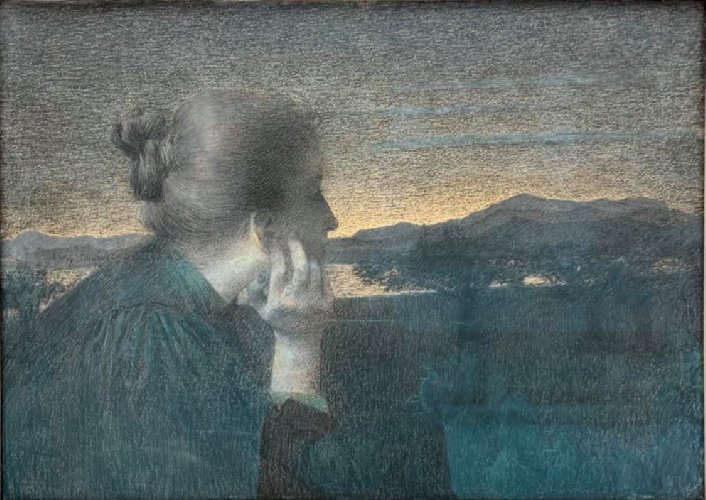Description:
Lucien Levy-Dhurmer (1865-1953) was a French painter, graphic artist, interior designer, gobelin designer and wallpaper designer. In 1879, he began his studies at the École Communale Supérieure de Design et de Sculpture, where he began to create his first lithographs. From 1887–1895 he worked as a decorator at an artistic porcelain factory, where he eventually became the director and revived forgotten techniques. After a trip to Italy in 1895, he began to paint. He exhibited his works from 1896. In his work he focused on symbolic painting, portraiture, and was also inspired by Pre–Raphaelite, mythological and musical themes.
Description of the painting:
The artist has depicted a portrait of a woman gazing at the setting sun on the canvas. The model is shown in a bust–length view from the side. She has her head resting on her right hand. Her face is indistinct, immersed in the darkness. The woman is wearing a loose dress and her hair is tied in a bun. She looks lost in thought, staring ahead. In the background, a mountain range is visible, with a lake stretching in front of it.
The painting is almost monochromatic, kept in shades of gray broken by the golden sunset reflected in the lake‘s surface. Using light and shadow the artist emphasizes the woman‘s neck and hand. He also emphasizes the reflections in her hair and the folds of her dress. The structure of the landscape in the background can be recognized by its outlines. The lightening of the central part of the painting gives it depth and emphasizes the contour of the model‘s profile. The work encourages reflection and contemplation. The melancholic mood is emphasized by the feeling of haze. The model depicted on the canvas is probably Marguerita Moreno, a popular Parisian actress at the time. The woman was often portrayed by Levy–Dhurmer. The work is another step in the evolution of the artist‘s style, who in the 1890s created works in a subdued, almost monochromatic palette.


